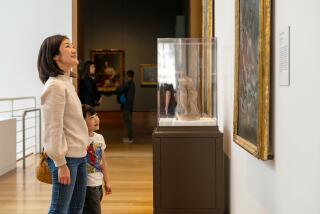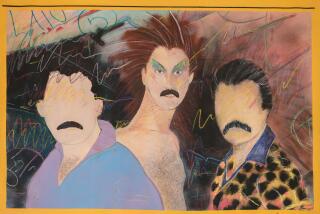The soul of Oceania
“Just look at the noses,” says Los Angeles collector Valerie Franklin, approaching a display of Melanesian masks at the San Diego Museum of Art. One resembles a sharply pointed beak, another curls into a spiral, yet another sprouts a branch that morphs into a bird-like form. A 19th century mask with a strikingly modern look has a relatively ordinary proboscis, but it anchors a twisted face with a haunting expression.
Noses are not the point of “Oceanic Art: A Celebration of Form,” an exhibition of about 100 objects from Franklin’s collection and the holdings of Edward and Mina Smith, who live near San Diego. But fascination with details is a pathway to understanding a swath of cultural history that can be baffling for novices.
“The imagination that’s manifest in the art brings the creative impulse to life,” Franklin says. “There is an immediacy about the material that makes it very exciting visually. You could come back to the exhibition 50 times and see something different each time.”
Fifty return trips may be a bit much, but many more people are looking at Oceanic art these days. And not only at ethnographic repositories, as in the past, but in mainstream art museums. What’s more, Pacific Island art is about to get a showcase of its own in Long Beach.
In San Diego, “Oceanic Art” is paired with “Black Womanhood: Icons, Images, and Ideologies of the African Body,” a traveling show, as part of an effort to expand the Balboa Park museum’s global reach and attract a broader audience. “Black Womanhood” will end April 26; the Oceanic show will remain until Jan. 3 with a few changes from time to time.
The museum’s first exhibition on the subject in 40 years, it’s a welcoming gesture to Southern California’s large population of South Pacific Island people, says Executive Director Derrick R. Cartwright. But it’s also a timely event that taps into “burgeoning curiosity about the works of art that come out of [the region’s] inherently fragile, insular ecosystems,” he says.
Though far from a comprehensive survey, the show offers considerable insight into the art of Oceania -- the collective term for about 25,000 Pacific islands that are home to 1,800 cultures and hundreds of artistic traditions. Works on view include figurative sculpture, bark cloth, jewelry, baskets, ceramic containers, musical instruments, canoe ornaments, shields and weapons. Mostly made between the late 18th and early 20th centuries, they are the work of anonymous artists.
A particularly rare, life-size figure from Micronesia is carved of wood from a breadfruit tree. Other pieces make creative use of stone, grass, bark, shell, feathers, bone and human hair. The face of a wood canoe prow ornament from the Solomon Islands is decorated with trade beads, shells and pigments. A container made of a gourd, also from the Solomon Islands, is topped by a seated wood figure adorned with fiber, shell and rat teeth.
Varied as they are, all the works merge religion and spirituality with aesthetics and have ceremonial or practical functions. Carvings of gods, spirits or ancestors may double as architectural elements, handles of fly swatters or hooks that suspend food and other valuable goods out of the reach of animals.
“These are timeless works of art that complement our permanent collection,” Cartwright says.
But as George Ellis, a scholar of Oceanic art and director emeritus of the Honolulu Academy of Arts who guest curated the show, puts it: “This is not art for art’s sake. This is art that serves religious purposes and societal needs in a very real way that, for me, gives it a soul. It speaks of people, their fears, hopes and aspirations -- the same concerns we have but reflected in different forms. It’s exciting, wonderful art from a part of the world that we know very little about.”
Oceania’s rediscovery
Westerners have collected Oceanic art and artifacts since the late 18th century, but ethnographic institutions, such as the Field Museum in Chicago, have the largest holdings. Most art museums that have acquired Oceanic material have devoted little space to it beyond exhibitions that point out the influence of “primitive” art on Western modernists.
But the star of Oceanic art is rising at museums and in the marketplace, where a rare work with an impeccable provenance can bring hundreds of thousands of dollars.
The M.H. de Young Memorial Museum in San Francisco attracted international attention in 2005 when it landed a 3,000-piece trove of art from New Guinea, valued at $100 million, as a promised gift from New York collectors John and Marcia Friede. The museum’s new building in Golden Gate Park opened a few months later with about 350 Friede works installed in a large gallery named for the donors. Although the gift has become embroiled in a family feud, the installation remains intact and museum officials are hoping for an amicable resolution.
Christina Hellmich, curator of Oceanic art at the De Young, is one of the few Oceanic specialists in America’s art museums, but she has seen lots of action at other institutions. Art museums in New York, Seattle, St. Louis, Minneapolis, Dallas, Denver and Salem, Mass., have reinstalled their Oceanic collections in the last decade, she says.
And like the De Young, Boston’s Museum of Fine Arts has introduced a large gift of Oceanic art in dedicated galleries. Most of the museums have also published scholarly catalogs on their holdings and presented related public programs.
“Though the influence of Oceanic art on modern art is still an important interpretive thread,” Hellmich says, “it no longer frames their importance. These collections are being presented and interpreted as works of art in art museums -- on their own terms with their multivalent meanings.”
Temporary exhibitions are still unusual, she says, but the one in San Diego is the latest example of Southern California’s rapidly growing interest in Oceania.
The Los Angeles County Museum of Art filled a big gap in its collection last summer with the purchase of 46 works from the Masco Corp. Foundation of Detroit. Funded by a $5-million grant from the Eli and Edythe Broad Foundation and donations from a coalition of LACMA trustees, the acquisition includes a Hawaiian drum collected by Captain James Cook in 1778 and a male ancestor figure and dance paddle from Easter Island, both carved around 1800. A selection will go on view at the museum in August.
“Even now, when the corpus of works available might seem small, making it difficult to build a great Oceanic collection, museums can acquire small groups of fine works and establish a presence for Oceanic art, as the recent LACMA acquisition illustrates,” Hellmich says. “Art museums now acknowledge -- through the allocation of precious space in their facilities -- the great importance of Oceanic art within world art.”
Several other local museums have quietly acquired Oceanic art over long periods of time. The prime example is UCLA’s Fowler Museum, which has built a distinguished 5,000-piece collection of objects from New Guinea and surrounding islands in the past four decades. It’s mainly used for research, but examples appear in exhibitions such as the recent “Ceramics of Papua New Guinea.” A traveling show of Oceanic material, “Icons of the Desert: Early Aboriginal Paintings from Papunya,” will open at the museum in May along with a related, Fowler-organized exhibition, “Innovations in Western Desert Painting, 1972-1999: Selections from the Kelton Foundation.”
Santa Ana’s Bowers Museum has amassed about 2,400 objects from the Pacific Islands -- basketry, pottery, feather work, weapons, wooden sculpture, food bowls and utensils, jewelry and costumes -- some of which will go on view next year in “Spirits and Headhunters.” Organized by photographer Chris Rainier, the exhibition will be accompanied by 50 of Rainier’s images of the people of Papua New Guinea and Irian Jaya, or West Papua, Indonesia.
In Pasadena, the Pacific Asia Museum has about 800 Oceanic objects that range from rare pieces to items made for the tourist market, chief curator Ken Brown says. Only a few are on view, but he is thinking about a new display that might complement LACMA’s upcoming installation and a long planned museum in Long Beach.
Expected to open this summer, the Pacific Island Ethnic Art Museum will fulfill a dream of the late Dr. Robert Gumbiner, a physician and HMO pioneer who founded Long Beach’s Museum of Latin American Art. An inveterate collector who became interested in Oceanic art while building a health center in Guam and operating clinics on other Pacific islands, he established the Ethnic Art Institute of Micronesia in Yap (part of the Federated States of Micronesia) in 1994 to revive lost arts of the region.
The institute’s former director, Brenna Barrett, will oversee the new facility, endowed by Gumbiner and located near MOLAA in a 2,400-square-foot building with a sculpture garden of the same size. Program plans have only begun, she says, but the museum is expected to present rotating exhibitions and related events along with a collection amassed by Gumbiner.
More to Read
The biggest entertainment stories
Get our big stories about Hollywood, film, television, music, arts, culture and more right in your inbox as soon as they publish.
You may occasionally receive promotional content from the Los Angeles Times.






